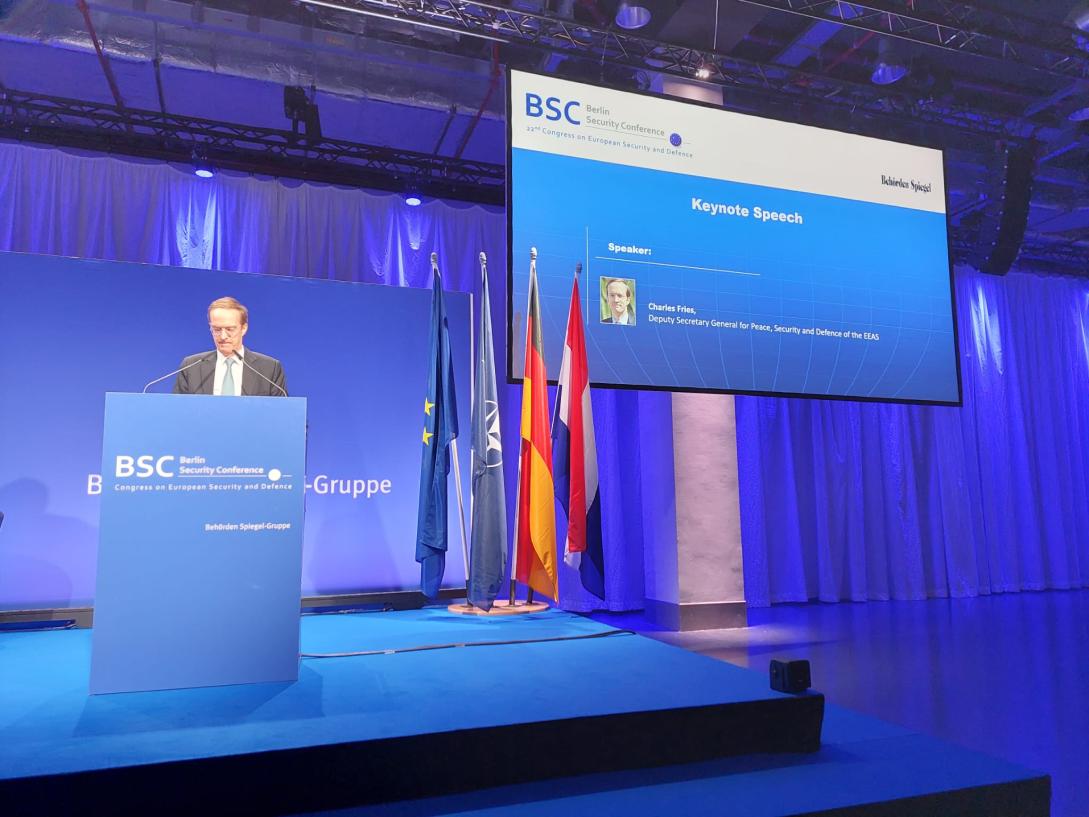EEAS at the Berlin Security Conference

I am pleased and honoured to represent today the European External Action Service, where I am responsible for the European Union’s security and defence policy.
Two years ago, when the High Representative for Foreign Affairs and Security Policy, Josep Borrell, presented the first draft of the “Strategic Compass” – our common strategic vision for EU security and defence – he warned that “Europe is in danger”. This was in November 2021: before Russia’s war against Ukraine; before the severe degradation of the democratic and security situation in the Sahel; before the mass exodus from Nagorno-Karabakh and the renewal of tensions in Kosovo and Bosnia Herzegovina. And it was, of course, before the major and tragic escalation in Israel and Gaza. And so in the course of the last two years, the danger for Europe has only grown.
At the European Council in mid-December, the 27 Heads of State and Government will once again discuss security and defence. I would like this morning, firstly, to draw some lessons from these two years with the return of war on European soil, and then to highlight the main priorities of our security and defence agenda for the coming months.
First, some lessons from the past two years.
Russia’s invasion of Ukraine was a “tectonic shift” for Europe and its security: a “Zeitenwende” for Europe.
Indeed, the European Union has since not only demonstrated once again that we are able to make major leaps forward in times of crisis, as with the Covid pandemic, but also to confront many long-standing taboos.
For the first time, the EU has financed the delivery of military equipment to a country at war. EU military support to Ukraine is unprecedented, with more than EUR 27 billion so far, through bilateral donations by Member States and the European Peace Facility. The latter has proven to be a game changer by incentivising Member States to give more equipment to Ukraine in exchange for reimbursements - making it possible to replenish their stocks. With the European Peace Facility, the EU has shown political and financial solidarity.
A year ago, the EU launched the largest military mission in its history to train the Ukrainian army - 34 000 trained so far, 10 000 more in the upcoming period. 24 Member States have offered training and I would like to pay tribute to Germany for its key contribution to this effort.
The EU has also embarked on new projects that were unimaginable before the start of the war. It has boosted support for its defence industry, meaning that the EU budget no longer finances only research and development projects through the European Defence Fund but goes much further. It incentivizes Member States to jointly procure military equipment and encourages companies to produce more and quicker ammunition/missiles.
All this was unthinkable before the war.
However, this war has also revealed our weaknesses: a lack of investment in our defence apparatus; a lack of coordination and interoperability. And the result is that we have supported Ukraine by exporting our own fragmented armament market. Former Ukrainian defence minister Reznikov even talked about Ukraine becoming a “military zoo”.
As Minister Pistorius rightly pointed out, we have to make our countries “war capable”, which they simply are not. We have understood this and are adapting, but it will require a shift in mind set, both politically and industrially; both across the EU and at the national level.
This lack of preparedness is a problem for both European and Transatlantic security. For instance, we can see the challenge for many Allies to meet NATO capability targets. We now need to fix this collectively.
Since 2014 and with a clear acceleration due to the war, EU Member States have increased their defence spending, only just beginning to compensate decades of under investments. But it is not because we spend more that we automatically spend better – I mean together. We need to maximize economies of scale. More coordinated investments will result in more opportunities for Europe’s defence industry.
Encouraging Member States to procure together is at the heart of our ammunition initiative. We have put in place an ambitious framework, supported by 2.5 billion EUR. We have incentivised the delivery of ammunition and missiles to Ukraine, and, at the same time, the ramping up of industrial production in Europe. An agreement of this kind at EU level is unprecedented, particularly through joint procurement from the European defence industry.
Germany is a key contributor to this collective endeavour. It has aggregated its demand with the Netherlands, Denmark and Estonia passing joint contracts for their own stocks and for deliveries for Ukraine. Sweden has done the same with few other Member States. And importantly, the European Defence Agency has passed contracts on behalf of 7 EU Member States, something that the Agency had never done at such a scale.
The objective to deliver one million rounds of ammunition to Ukraine is ambitious. We knew it from the beginning. But we should not forget from where we were starting. At the current pace and thanks to EU and Member States’ efforts, the European Commission considers that the European defence industry will be able to produce 1 million round of 155mm ammunition by next Spring and close to 1.5 million by the end of next year. What is needed is to continue investing in industrial ramp-up, help companies to have better access to financing and, finally, for Member States to pass many more contracts!
We should not always assume that it is easier to find equipment and ammunition outside the EU: many of our partners are dependent on European production and there are other third country producers who have a no-export policy to Ukraine.
One of the key lessons from this war is that a strong European defence industry is a key element of European sovereignty.
Turning now to our priorities for the coming months.
Our first priority is to continue our support to Ukraine, particularly in light of current discussions in the US Congress, the hard winter ahead and our depleted stocks in Europe. In this context, the upcoming European Council in mid-December is especially important. Like the other members of the G7, the European Union is currently working on its contribution to the future security commitments for Ukraine. The High Representative, who has been mandated to conduct these consultations with Kiev, will report to EU leaders at this occasion. The aim is to help Ukraine to defend itself, resist destabilisation and deter acts of aggression in the future.
Security and reconstruction go hand in hand. This is why, as a complement to the Ukraine Facility for reconstruction proposed by the European Commission, the High Representative has proposed to continue the EU’s military support through a dedicated financial envelope within the European Peace Facility – a so-called Ukraine Assistance Fund. Discussions are ongoing with Member States on this proposal.
Obviously, this Fund will continue to respond to Ukraine’s needs. It should draw inspiration from what we have done with the ammunition initiative: shifting from destocking to more procurement, mobilising the European defence industry, creating incentives for more joint procurement, providing support to Ukrainian defence industry, fitting together with the “capability coalitions” set up within the Ukraine Defence Contact Group.
To this end, we hope that EU Leaders will agree on a new top-up for the European Peace Facility in 2024. This would not only be a strong signal of our firm support to Ukraine, but also a strong signal to Russia that there is no European “fatigue” – and to the US that the Europeans are sharing the burden.
Our second priority is to improve the EU’s defence readiness.
This demands greater freedom of action. Indeed, I want to stress the progress we have made in implementing the “Strategic Compass”, particularly in developing an EU Rapid Deployment Capacity of up to 5000 soldiers. We held the first live EU military exercise in Spain in October. We are reinforcing our command structures. We now have the tools to conduct systematic contingency planning. I would like to remind that this EU Rapid Deployment Capacity will focus on crisis management operations outside the EU’s borders and is therefore in full complementarity with NATO’s role in collective defence. Here, I would like to pay tribute to the support of Germany, as well as the Netherlands, for their continuous support to make it a reality in 2025: by providing high readiness forces on standby in 2025 and offering critical communication systems to the EU headquarters.
Defence readiness also applies to the European Defence Industry. The response of the EU and its Member States to the immediate challenge posed by Russia’s war has been rapid and decisive. But, it is now time for the EU to move from an emergency response to building the EU’s long-term industrial readiness.
A new European Defence Industrial Strategy will be presented early next year. This strategy – the first of its kind – must allow us to invest better in priority capabilities, to invest together by “Europeanising” the demand and procuring jointly, and –finally– to strengthen the European defence industry by reducing dependencies. I referred earlier to restrictions imposed by the export policies of some partners. For instance, to produce our ammunition we are over reliant on explosive powder from certain partners that cannot be exported to Ukraine. We need to tackle these strategic dependencies: this is essentially “de-risking” in the defence domain.
This future strategy will be an opportunity for the Union to discuss if we can extend our model for ramping up production in ammunition to other defence sectors, such as drones or other critical products which we know we will need in Europe and also in Ukraine.
The final priority I would like to highlight here is to further deepen our partnerships.
Acting in coordination with partners is in the EU’s DNA.
In particular with NATO and its Allies. It is clear to us that a stronger and more capable EU will positively contribute to global and transatlantic security. With 22, and hopefully very soon 23, common members this is not only good logic, but in our shared interest and to our mutual benefit. A strong European pillar in NATO is good for the European Union and makes the Alliance stronger.
Since the start of the invasion, the EU and NATO have acted in full complementarity: with NATO focusing on the collective defence of its Allies and the EU mobilizing a wide set of instruments to weaken Russia and support Ukraine, for instance on delivering weapons to Kiev – which was, for understandable reasons, impossible for NATO as such. It is vital for the EU and NATO to continue this strategic partnership making the best out of their respective strengths and assets.
To conclude, the circumstances have forced us to make leaps forward in the EU’s security and defence agenda. The EU has assumed its strategic responsibility and a huge amount of progress has already been made in a short space of time.
But we also need to be lucid. We need to do much more if we are to confront the dangers I described at the beginning. And I believe that we need to do so together if we want to make us all stronger.





